Queens Game explores the potential of the computer as dramatic storytelling medium, using Unreal 3D Creation Tool and Games Engine to create something more than a game – storyplay.
It brings together advanced cinematic-language and interactive-media storytelling research with 3D interactive games-development for entertainment, addressing engaging, dramatic narrativity on the frontiers of film, animated musical, period drama and interactive game.
Queens Game provides a game of exploration, set in a virtual now-lost 14th-century historical castle where you can get to know the child-queen who lived there, and gain insight into her time. It also offers the experience not only of a medieval tale of adventure, but also of a medieval way of telling it - forgotten for 600 years but now made possible again by contemporary games technology.
Oral-composition and storytelling modes common in the middle-ages are intrinsically spatially-organised and non-linear, lending themselves naturally to computer-handled narrativity, which is not confined by the linear page-structure of books or the framing of the fixed screen or stage.
STUDIO LABORATORY PILOT DEMONSTRATOR RESEARCH PRODUCTION
The year is 1363. Queen Margrete (formerly Princess of Denmark) arrives at Akersborg – today’s castle of Akershus, Oslo – as the 10-year old bride of 23-year old King Håkon VI of Norway. Players explore, with Margrete, the virtual medieval royal stronghold - most of whose physical buildings no longer exist today. Little is known of Margrete’s actual childhood (for medieval childhood, see Orme, 2016); this gamestory is an imaginative dramatization of her introduction to her new home
Queens Game transposes the classic ‘story within a story’ narrative into the gameworld, inspired by the use of the format in the Round Table tale of the “Knight with the Lion”, translated from Chrétien de Troyes’ 12th-century French “Le Chevalier au Lion” into medieval Norse as “Ívens saga” (Bornholdt, 2015: 107-112), where the character Lunete is to be found. In this medieval tale, the hero is transported from the frame-story ‘real’ world of the court of Queen Guinevere and King Arthur into the timeless, enchanted Realm of Adventure, where actions and characters challenge assumptions and values. In Queens Game, Margrete – with the player - is transported from the ‘real’ 14th-century castle of Akersborg into this same enchanted, timeless and challenging realm of Arthurian advenure.
From Lunete’s adventures in the Round Table World, the player, as well as encountering the lives and crafts of people outside the confines of the castle, discovers some additional skills needed by a girl who is to become an active medieval queen.
Margrete was effectively sole regent of the whole of today’s Scandinavia (the Kalmar Union, which she was instrumental in bringing about) by the time she was 35, and ruled in her own right till her death aged 59. The traits that game-Margrete/Lunete need to negotiate their world – for example: confidence, courage, kindness and initiative - are skills girls today sometimes struggle to acquire and use in their daily lives. It is hoped that the example of a real medieval princess (not a spun-sugar fantasy) who achieved greatness by her own efforts will help to encourage and inspire girls today.
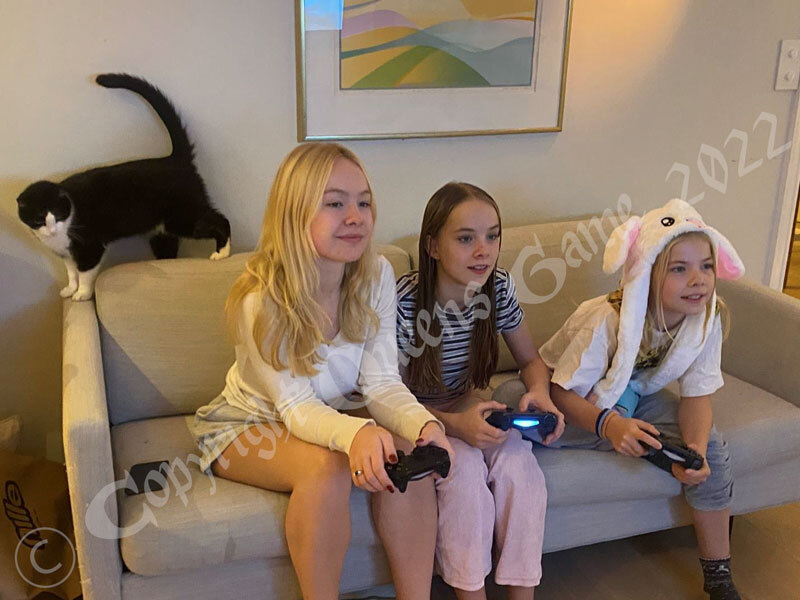
GAMEPLAY
Gameplay analysis suggests that the top 3 activities for female players, who tend to “want to make creative choices”, are puzzle solving, gathering, build and design (Brune, 2021), atmospheric exploration and interactive drama (Campbell, 2017), all fundamental to Queens Game.
As Brie Code, previously an AI programmer at game-developers Ubisoft and Relic Entertainment, since 2016 director of her own company, TRULUV Studios, Canada, an avid gamer herself, points out, girls and women often “don’t like video games” because they “think video games lack depth”; and that from them they “don't learn anything or change as a person" - or else are “just flat out repulsed by video games. Few women, for example, are going to play a video game with terrible portrayals of women”. Code found these unconvinced players were irritated by “failing at things [they] didn't care about in the first place” and put off by the fact that “they don't find their own cultural references or interests in video games” (Code, 2016).

Queens Game explores the possibility of reaching out to players who are not attracted by conventional hardcore, casual or serious games, but might enjoy taking an active part in character-based storymaking incorporating situations, challenges and activities that genuinely appeal to them – particularly girls who don’t usually find their own interests reflected in games.
Queens Game is not adrenaline-driven; no-one gets shot or tortured or hacked to death; and it does not offer rewards or prizes for speed, competition, violence or successful combat. Players can collect the fantasy chess-pieces which make up Margrete’s set, to access original songs which occur in different episodes in the gameworld - you collect songs and music, rather than weapons or material possessions . The emphasis is on exploration and creativity. Experience points can be gained for kindness and collaboration, as well as courage, confidence and initiative.

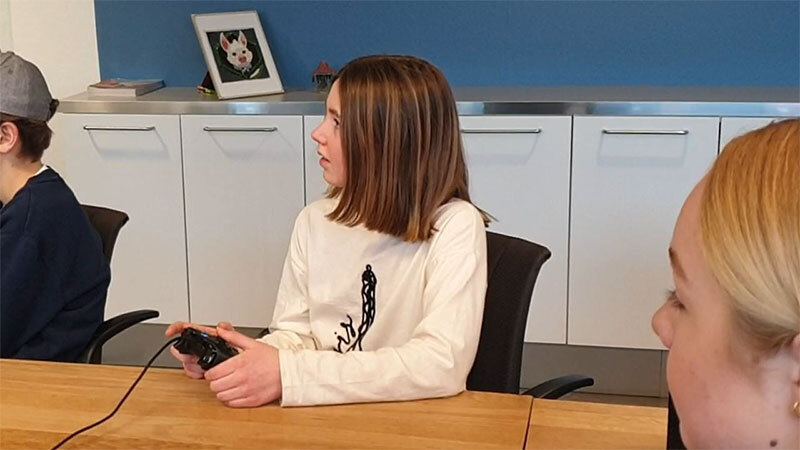
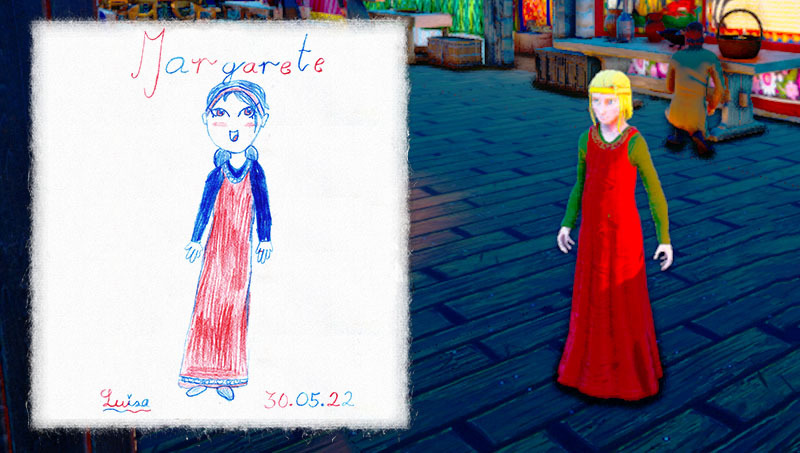
Queens Game’s incorporation of chance operations and reconfigurable, spatially-organised narrativity, including music and dialogue which is never repeated in a session, aims to make it surprising, however often it is played by those who fall under the spell of its medieval world, its music and its characters.
REFERENCES
- Bornholdt, C. (2015). The Old Norse-Icelandic transmission of Chrétien de Troyes’ romances. In M. Kalinke (Ed.) The Arthur of the North, (pp. 107 – 112). University of Wales Press.
- Brune, M. (2021). Zooming in on female gamers with consumer insights data. Newzoo March 31, 2021. https://newzoo.com/insights/articles/zooming-in-on-female-gamers-with-consumer-insights-data/.
- Campbell, C. (2017, Jan 20). Which games are women and girls playing? Polygon. https://www.polygon.com/2017/1/20/14337282/games-for-women-and-girls.
- Code, B. (2016). Video games are boring. GameIndustryBiz, 07 December. https://www.gamesindustry.biz/...
- Orme, N. (2003). Medieval children. Yale University Press.
AUGMENTED REALITY
The Queens Game project, in addition to creating a prototype pilot video StoryGame, explored, with the Danish company Interaktive Oplivelser, the potential of an innovative on-site Augmented Reality experience at today’s castle of Akershus, incorporating research and some assets from the game. The ic3d stereoscopic viewer is an effective, convenient device for viewing recorded ingame footage, providing instant time-travel by enabling visitors to the castle to explore, from within the locations themselves, the virtual furnished and populated rooms and courtyards of Queens Game’s (Unreal Engine) navigable castle of Akersborg, as it was in the fourteenth century. No other interaction device – such as tablet, smartphone, headset or goggles – is necessary for the ic3d AR experience. This offers instant, situated, hands-free immersion in the colourful and dynamic animated world of the past created for Queens Game.

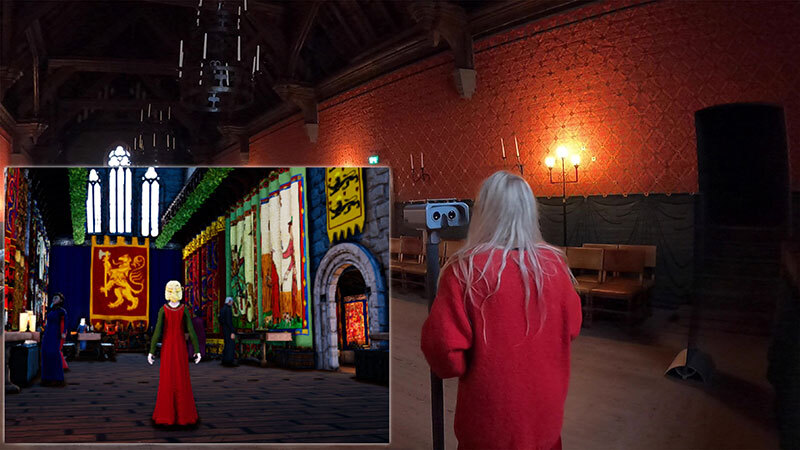
DISSEMINATION
Exhibition
Part of Queens Game was included as a standalone interactive exhibit, 'Medieval Akershus Castle', in the international exhibition ‘Vår fru dronning Margrete - Our noble lady Queen Margrete’ (March 2022 – September 2023: https://kultur.forsvaret.no/fo...).
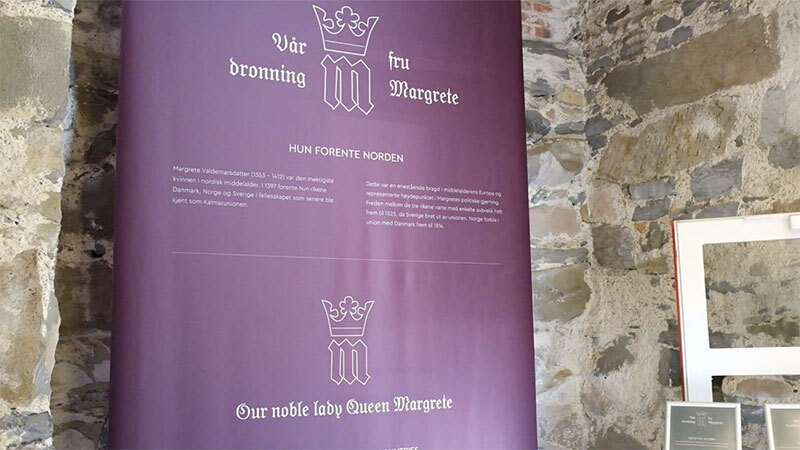
As well as the explorable model of the real medieval castle, most of which is no longer visible after the ravages of time and rebuilding, this interactive exhibit, designed to fit the timescale of a museum visit, includes characters and original dialogue and music from the pilot Queens Game.
As an owl or a cat, you can travel through time to visit the castle, furnished and populated as it was in the 14th century. You can overhear the conversation of the inhabitants of the castle as they go about their business in the North Wing, where the kitchens and great hall are situated.
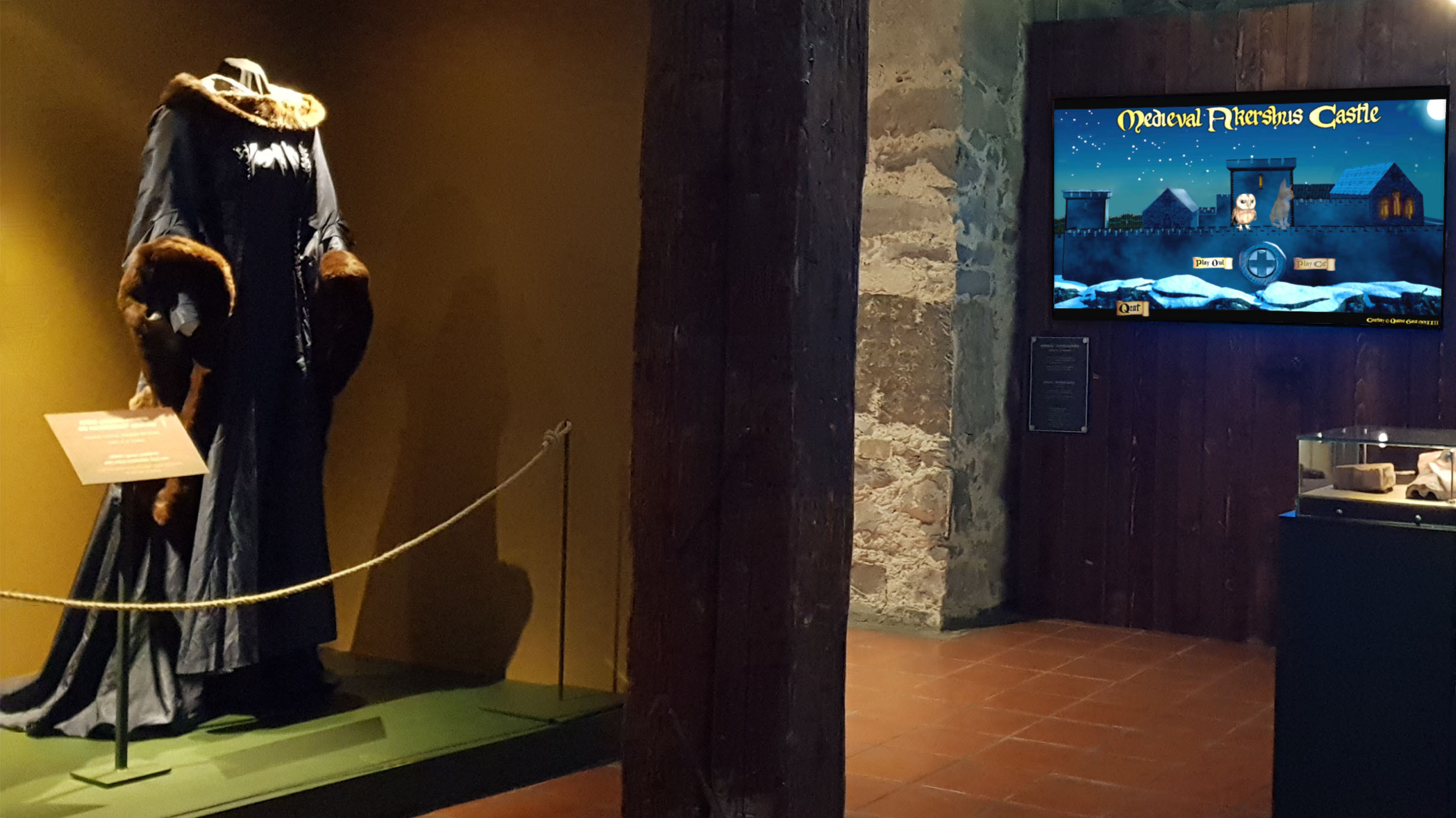
Extended Media agreed with Queens Game and Akershus Castle Visitor Centre in July 2023 to upgrade the interactive exhibit, which, after the temporary exhibition was over, went on permanent display at the Visitor Centre in February 2024, as Medieval Akersborg.
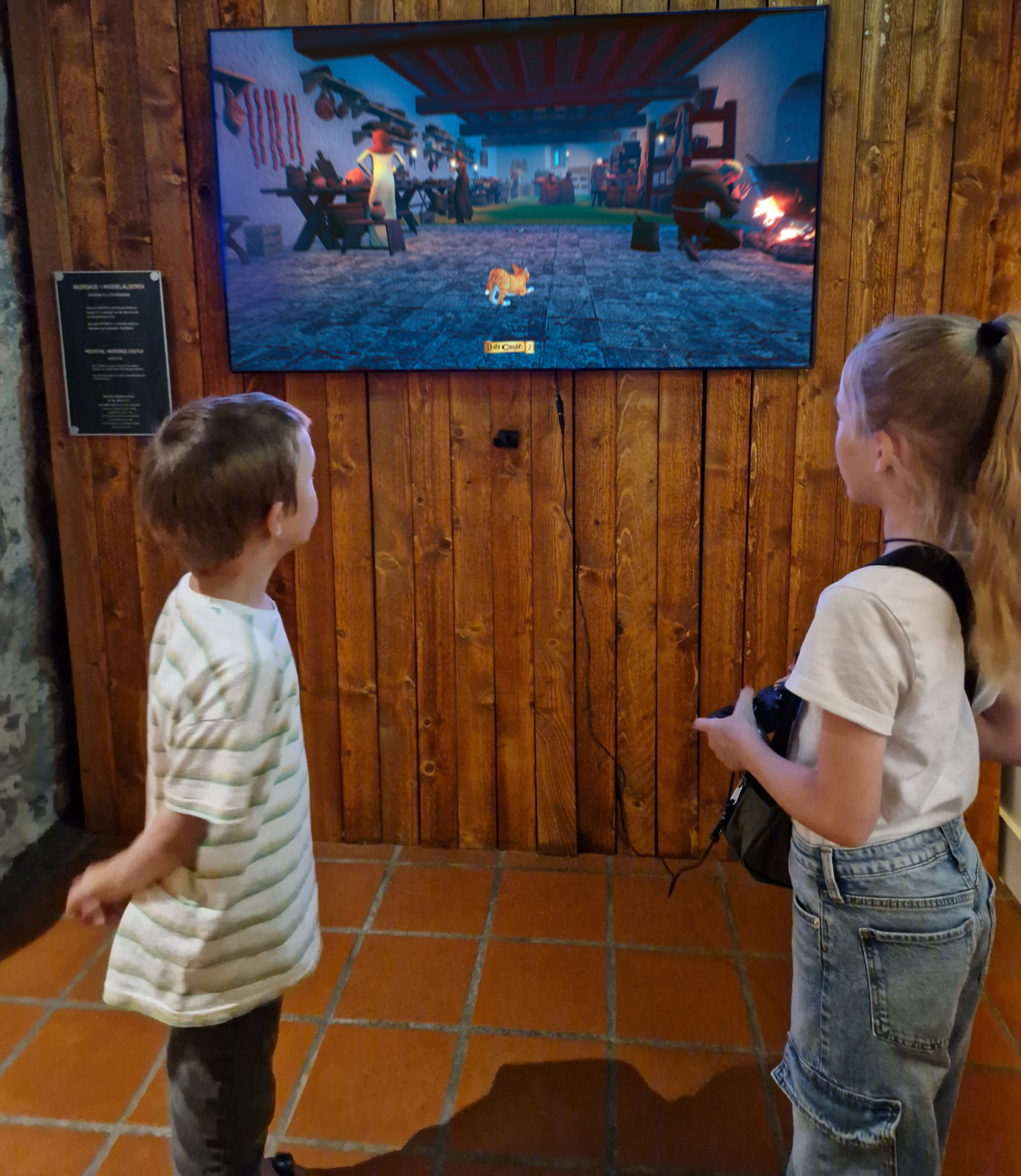
The virtual castle in Queens Game and the exhibit was carefully researched, and is now the best representation of the lost castle available. Some fragments of the old walls survive, but most have vanished or have been built over in the course of the centuries.
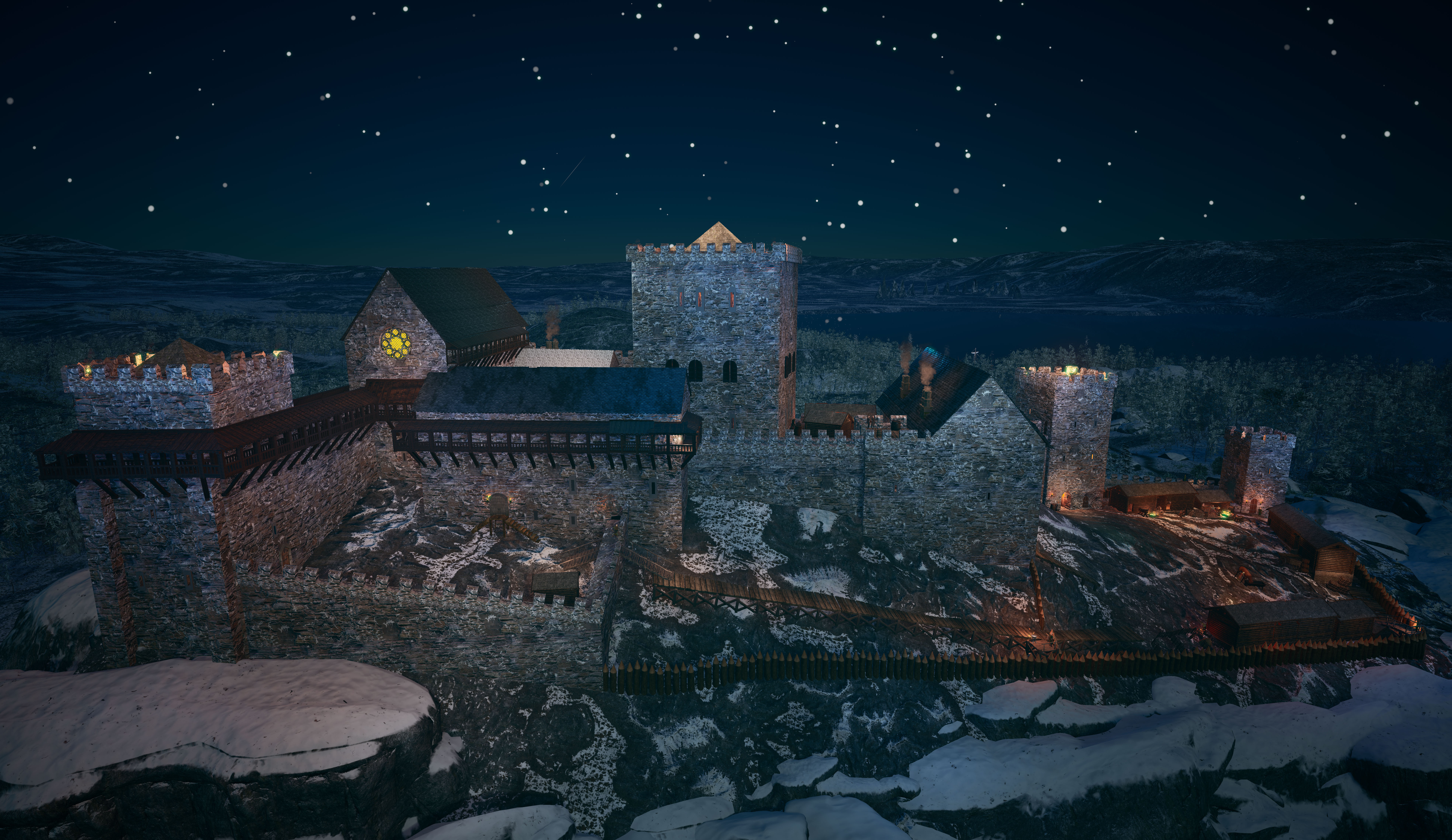
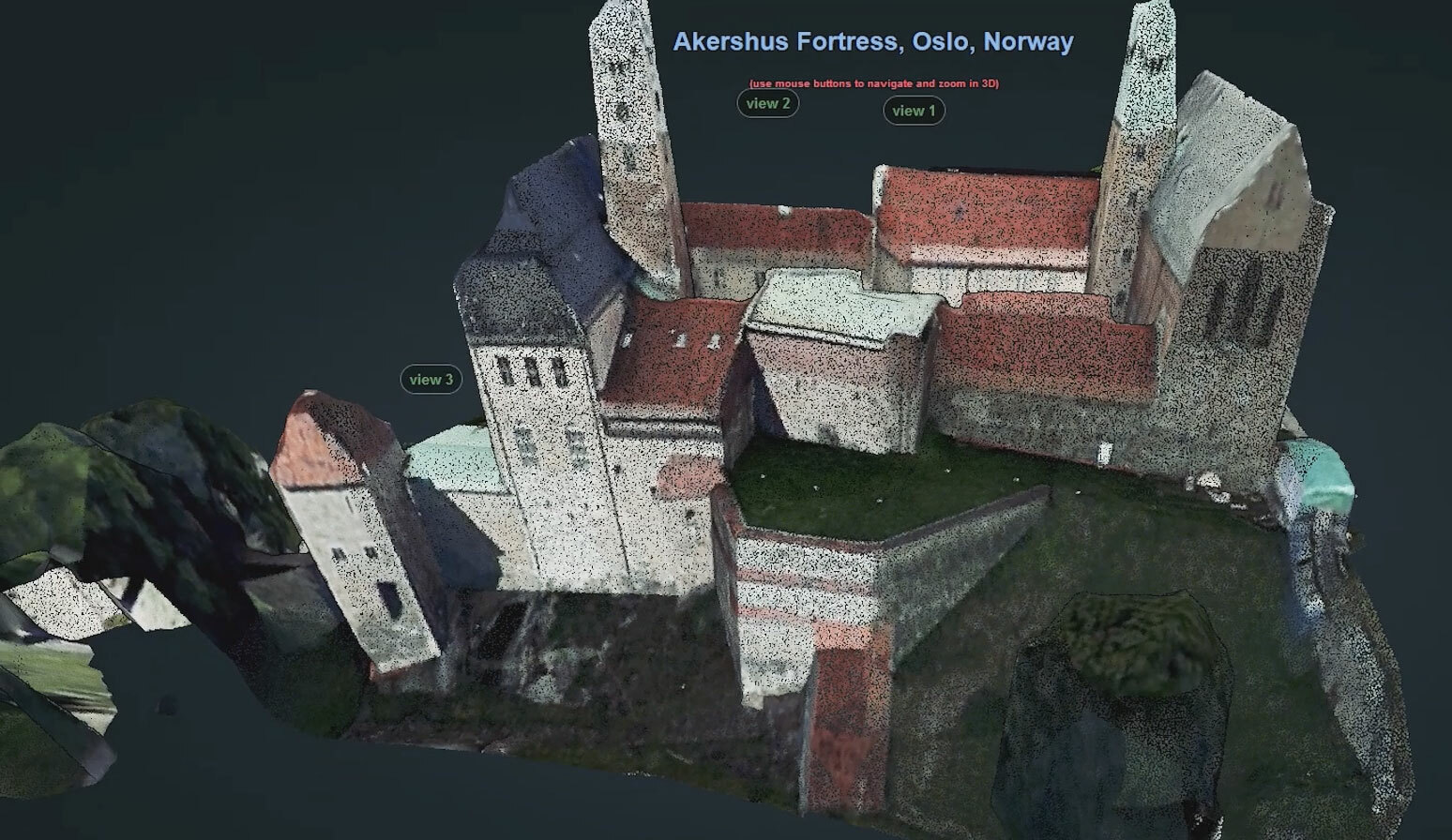

The research and studio laboratory pilot production were presented to the public and made available to play, as new outcomes of the Program for Kunstnerisk Utvikingsarbeid, at the Artistic Research Cafe, Myrens Verksted, Oslo, in May 2022, followed by Q & A and discussion.
Publications
Thomas, M. & Stang, B. (2022). A serious game for cultural heritage?, pp. 334 - 374 in O. Bernardes & V. Amorim (Eds.). Handbook on promoting economic and social development through serious games. IGI Global. https://www.igi-global.com/book/handbook-research-promoting-economic-social/281145
Thomas, M. (2021). Cinematic forms and cultural heritage, pp. 122 -141 in Breeze, M. (ed). Forms of the cinematic. Bloomsbury Press.
Presentations
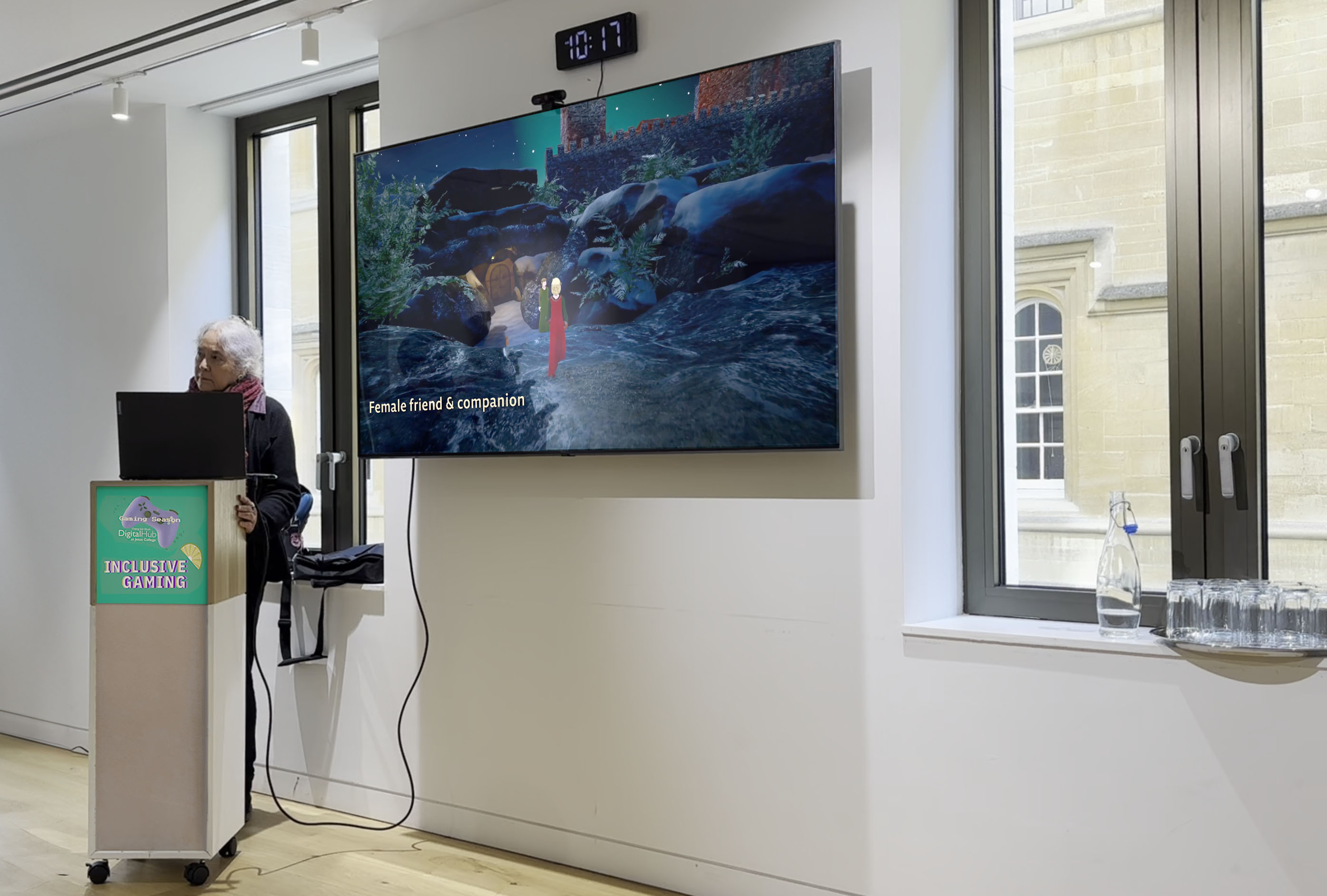
- Inclusive Gaming Conference, University of Oxford, 01 May 2024. Professor (emeritus) Maureen Thomas (Norwegian Film School) presents Queens Game.
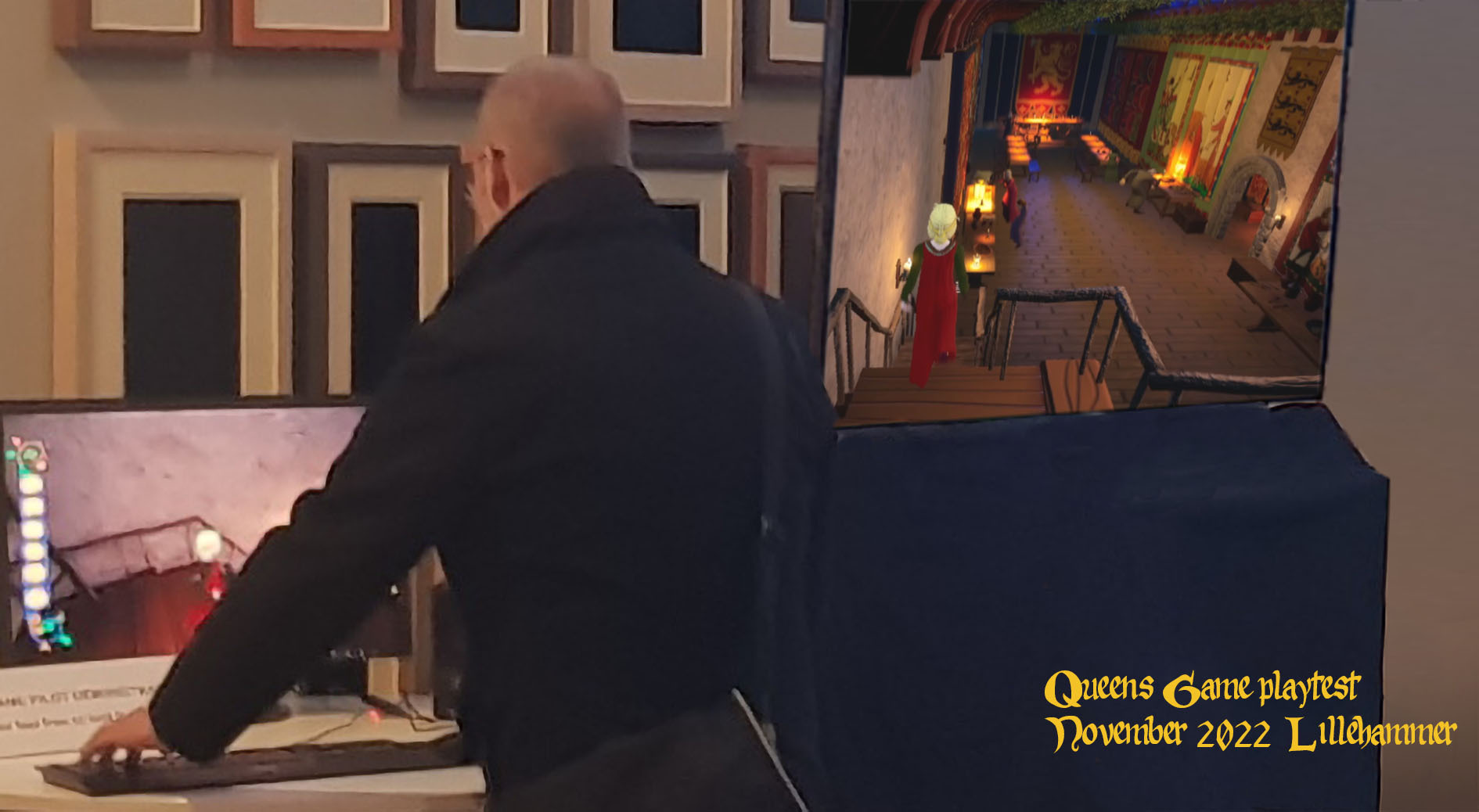
- 25th Anniversary Celebration, Norwegian Film School, Inland Norway University Lillehammer Campus, 30 November 2022. The Queens Game pilot demonstrator is tested by visitors to the public exhibition-space, where it is available all day. https://www.inn.no/om-hogskole...
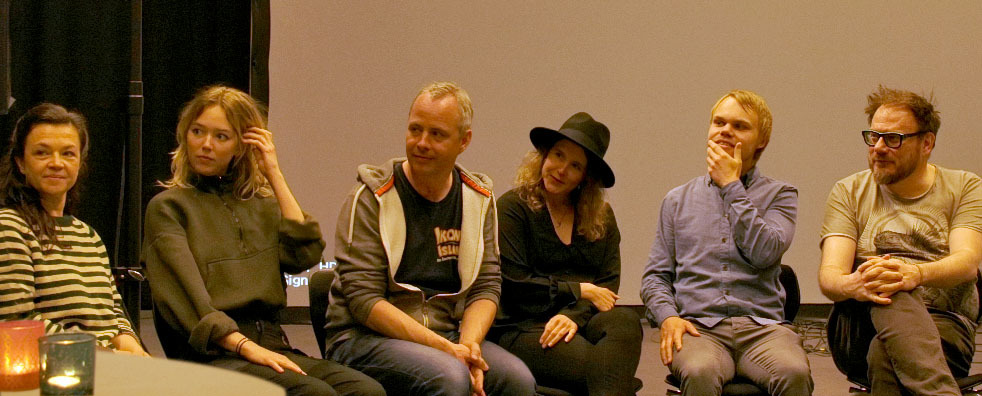
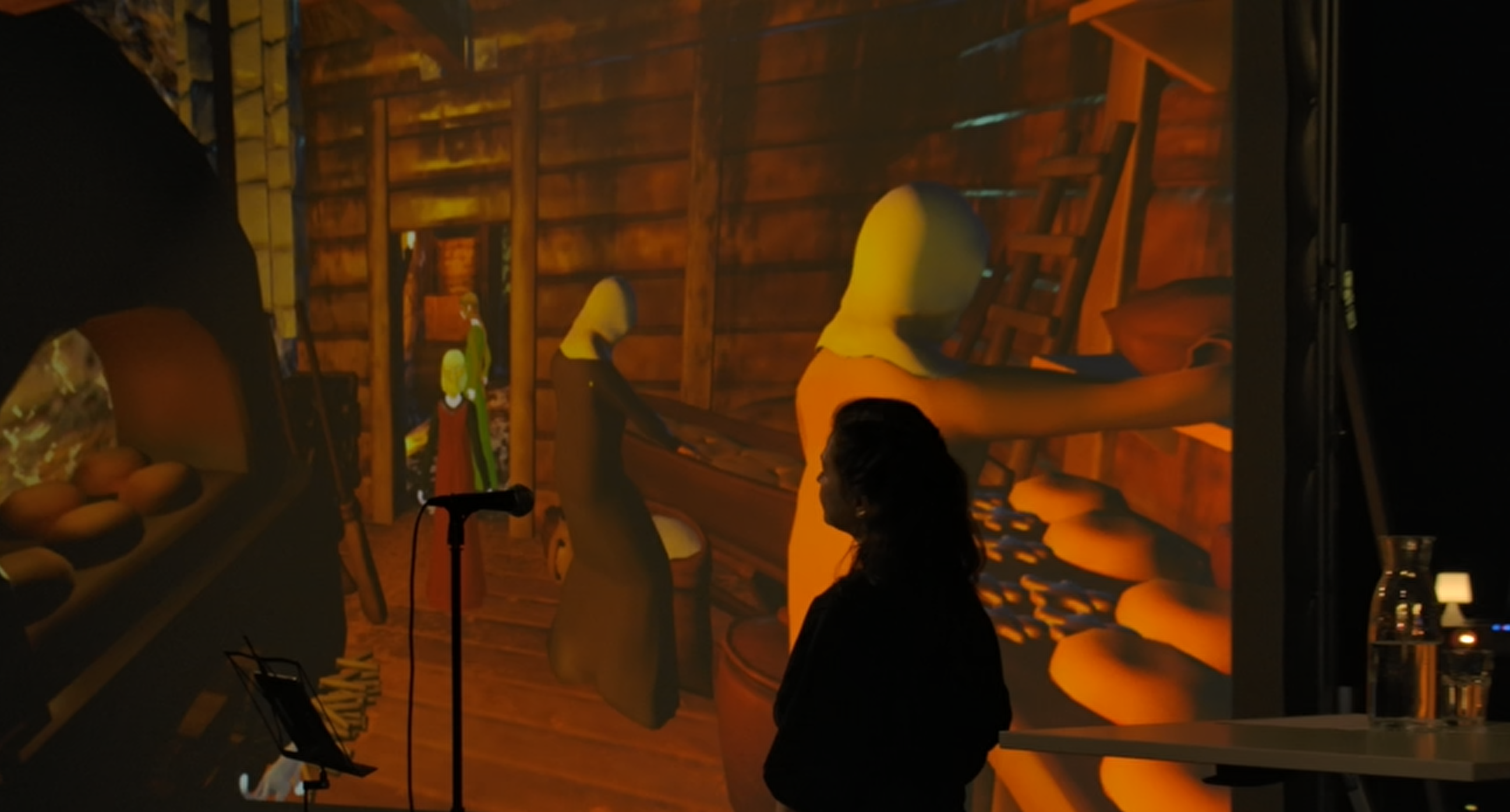
- Artistic Research Café (https://www.filmskolen.no/en/r...) Norwegian Film School, Oslo, 30 May 2022 Professor Maureen Thomas (Norwegian Film School) & Bendik Stang (Executive Creative Director, Snowcastle Games Oslo) present and demonstrate Queens Game live. Kariina Gretere sings her settings of original lyrics by Maureen Thomas composed for Queens Game against a projection of Medieval Akersborg Castle from the HiStoryGame played live by Wenche Hellekås. Sound mixed live by Idunn Snædis Agustsdottir. Immersive contextualising 3D animated visuals created and mixed live by Rafal Hanzl.
- PKU Artistic Research Forum (online) 14 March 2022 Professor Maureen Thomas (Norwegian Film School) Interactive Storytelling: HiStoryGame - Queens Game https://diku.no/en/events/artistic-research-spring-forum-2022
- Artistic Research Café (Norwegian Film School and Norwegian Film Institute Lab), Norwegian Film School Oslo (Online), March 2021 Professor Maureen Thomas (Norwegian Film School) & Game Developer and Director Bendik Stang (Snowcastle Games Oslo) in conversation: How can artistic research at a film school and professional practice at a games development/production studio benefit each other? Queens Game.
- Norwegian Artistic Research Forum, Norwegian Film School, Lillehammer September 2019 Maureen Thomas (Norwegian Film School) presents and Bendik Stang (Snow Castle) demonstrates Queens Game second pre-production prototype: June - September 2019 https://diku.no/arrangementer/artistic-research-autumn-forum-2019
- Artistic Research Café March 2019 Maureen Thomas presents Queens Game initial pre-production experimental prototype: January – May 2019 work achieved and in progress https://www.nfi.no/kalender/artistic-research-cafe
- Artistic Research Café (Norwegian Film School and Norwegian Film Institute Lab), Norwegian Film School Oslo, October 2018 Maureen Thomas presents Queens Game: proposed project https://www.filmskolen.no/artikler/2018/ar-cafe-1
QUEENS GAME CORE TEAM
Principal Investigator: Professor Maureen Thomas (research, story architecture, dramaturgy, dialogue, direction)
Senior Research Associate: Dr Rafal Hanzl (PhD, Leon Schiller Polish National Film, TV and Theatre School, Łódź. Norwegian Artistic Research Programme (PKU) Fellowship completed 2019). (3D sculpting, 3D model-rigging, 3D castle modelling, Unreal Engine project optimization, Unreal texture creation, 2D-animation, panoramic site photography, video editing, Perforce management, web-design, graphics, creative technology research)
Creative Practice Research Assistants:
Kariina Gretere (MA Music Therapy, Roehampton University, London; MMus Composing for New Media, London College of Music and Media; BA (Hons) Humanities with Music, Liverpool Institute for Performing Arts/Open University UK) (music and sound)
Wenche Hellekås (MFA Animation Storytelling, Norwegian Film School; BA 3D Animation, the Gameschool, Hamar) (concept art, 3D character art, modelling and animation)
Sindre Lie (BA Game Design, Vocational Diploma 3D & Animation, Westerdals Kristiania University College) (3D art, environment design)
Carlos Maldonado (Bachelors’ programme, Animation and Digital Art, Inland Norway University, Hamar campus, 2019-22) (Rigging and animation)
Johannes Skjeltorp-Borgaas (Bachelors’ programme, Game Technology and Simulation, Inland Norway University, Hamar campus, 2019-22) (Unreal programming)
Amir Soltani (BSc Computer Science University of Tabriz; PhD candidate, Dept of Architecture, University of Cambridge; Director, metrowave) (historical architectural modelling)
Emil Walseth (Noroff University College Bergen (2020 – 23) 3D and Animation; Åsane Folkehøgskole: Game Development (2020) (Unreal programming)
Iðunn Ágústsdóttir (BA New Media Music Composition, Iceland University of the Arts) (audio)
Special thanks to:
Ann Iren Bratt (financial management, co-ordination and support, Den norske filmskolen)
Christian Fremming Olsen (technical art – player-character model rigging)
Christopher Hobbs (design - chess pieces)
Interaktive Oplevelser ApS (ic3d stereoscopic viewer)
For Snowcastle Games A/S Oslo:
Erik Hoftun (liaison, co-ordination)
Nikola Kuresevic (games design)
Bendik Stang (games design)
Fredrik Tyskerud (initial player-character modelling)
Snow Castle interns from Westerdals Kristiania University College, Oslo (2019):
Alexander Espeseth (project management)
Terje Ballestad (game design)
Erik Holst (sound)
Sindre Lie (3D art, environment)
Sindre Majgren Uthaug (3D art, character models)
Matthias Tellefsen (programming)
Rolf Jackob Thommesen (3D art, rigging, animation)
For the Norwegian Armed Forces Museum and Visitor Centre, Akershus Fortress and Castle:
Tom Andersen (Chief Curator & Historian)
ABOUT PROFESSOR MAUREEN THOMAS
Professor Maureen Thomas has integrated her love of medieval literature, drama and oral tradition into much of her creative work since graduating from the University of Cambridge, where she read English Literature and Drama with Anglo-Saxon, Norse & Celtic. A Dame Bertha Phillpotts Bursary enabled her to carry out research at the Institute of Icelandic Studies, Reykjavik on myth as drama and the chivalric legends in Old Norse/Icelandic, before becoming a tutor and research fellow at University College London’s Dept of Scandinavian Studies. In parallel, while working as a dramatist and director (and script-reader for Channel Four Films), Maureen was a tutor in Screenwriting at the National Film and Television School UK, also developing and guiding film, TV, animation and documentary projects; she became Head of Screen Arts there in 1994. In 2000, after working with Norsk Film and Statens Studiesenter for Film, Oslo, Maureen was appointed Professor of Narrativity and Interactivity at the Norwegian Film School, where, since 2018, she has been a senior researcher and research advisor. In 2022 she was awarded the status of Professor Emeritus.
Selected Production Credits
- Homo Novus. 2018. [Screenwriter] (feature film adaptation of Anšlavs Eglītis Latvian novel) Director Anna Viduleja. Production: Film Angels. National Film Centre of Latvia Centenary Prize for Screen Adaptation (script); most-viewed centenary film - Rigas Nami Award; Latvian Film Prize. (Teaser: https://vimeo.com/251614479; Trailer: https://vimeo.com/280358531).
- WE. 2016. [Writer/Director] (integrated media ‘total theatre’ performance) with Studio for Electronic Theatre (www.setlab.eu), Roundhouse & Camden People’s Theatre, London.
- Marvellous Transformations. 2015. [Dramatist, Lyricist and Reconfigurable-voicescript Writer/Director] (installation – digital 3D art by Marianne Selsjord, supported by the Norwegian Arts Council; music by Kariina Gretere) (Jock Colville Hall, Cambridge).
- GhostCinema. 2013. [Story-architect, Director, co-Writer] (interactive locative Apple App) Production: Universities of Cambridge, Liverpool and Edinburgh in partnership with the Survey of London at English Heritage (AHRC-funded).
- Viking Seeress. 2010. [Story-architect, Writer, Director] (live integrated media performance using realtime navigable 3D ‘set’ on stage) with performers Kariina Gretere, Helen McGregor; designer Marianne Selsjord (MIST, Cambridge).
- RuneCast. 2007. [Interactive Story-architect, Writer, Director] (interactive cross-platform RT3DVE & video cultural heritage media art – installation and broadband for smartphone). Spatially-organised aleatoric dramatic & musical narrative based on Viking mythology and aesthetics (EU IP funded).
- Zuppa Inglese. 1993. [Librettist] (chamber opera - composer Daryl Runswick). Production Company: Pimlico Opera. Exhibition: Oxford Playhouse/Nottingham Playhouse/London RGS.
For young people:
- Alice. 2002. [Co-lyricist & Director] (stage musical from Lewis Carroll’s ‘Through the Looking Glass’ - composer Stephen Daltry – New End Theatre - voted #2 London Christmas Stage Show, by Sunday Times critics & children’s panels)
- About Face – Lombroso. 2001. [Lyricist] (opera - composer Rachel Leach - Linbury Theatre, Royal Opera House, Covent Garden, London)
- Bright Sparks. 1990. [Book and Lyrics] (Young People’s Pop/Rock Opera - composer Daryl Runswick - commissioned Arts Council West, UK)
- In Norway:
Aldri mer 13 (Goodbye 13). 1996. [Screenwriter with director Sirin Eide] (feature film). Production: Moviemakers. LUCAS Award for Best Film, Frankfurt International Festival 1996, and Best Film Award, Antwerp International Film Festival 1997.
Maureen’s creative practice research and teaching at Higher Education Institutions (incorporating doctoral supervision/examination) includes: University of Cambridge; University College, London; Narrativity Studio, Swedish Interactive Institute, Malmø; Media Lab, Aalto University, Helsinki; Digital Studios, Goldsmiths University of London; Dept of Art, Design & Architecture, University of Ulster; Welsh Film School, University of South Wales; National Film & Television School, UK (former Head of Screen Arts and Chair, Academic Standards Committee).
Selected Publications
- Thomas, M. & Stang, B. (2022). A serious game for cultural heritage?, pp. 334 - 374 in O. Bernardes & V. Amorim (Eds.). Handbook on promoting economic and social development through serious games. IGI Global.
- Thomas, M. 2021. Cinematic forms and cultural heritage, pp. 122 -141 in Breeze, M. (ed). Forms of the cinematic. Bloomsbury Press.
- Speed, C., Thomas, M. & Barker, C. 2017. Ghost Cinema app: temporal ubiquity and the condition of being in everytime, pp. 313-336 in Penz, F. & Koeck, R. (ed). Cinematic urban geographies. Palgrave Macmillan.
- Prager, P., Thomas, M. & Selsjord, M. 2015. Transposing, transforming and transcending tradition in creative digital media, pp. 141-199 in Harrison, D. (ed). Handbook of research on digital media and creative technologies. IGI Global.
- Thomas, M., Selsjord, M, & Zimmer, R. 2011. Museum or mausoleum? Electronic shock therapy, pp 10 – 35 in Lytras, Damiani, Diaz & Ordonez De Pablos (ed). Digital culture and e-tourism: technologies, applications and management. IGI Global.
- Thomas, M. 2009. Taking a chance on losing yourself in the game. Digital creativity, 20:4, 211–234 (Special Issue: Women in Games).
- Thomas, M. 2005
(i). Playing with chance and choice – orality, narrativity and cinematic media, pp. 371-442 in Bushoff, B. (ed.). Developing interactive narrative content: sagas/sagasnet. High Text.
(ii). The power of narrative: 2D, 3D, 4D', pp. 51-76 in Blackwell, A. & MacKay, D. (ed). Power. Cambridge University Press. - Thomas, M. 2003. Beyond digitality: cinema, console games and screen language – the spatial organisation of narrative, pp. 51 – 134 in Thomas, M. & Penz. F. (ed). Architectures of illusion. Intellect.
Web layout and implementation: Rafal Hanzl. Last updated May 2025.
